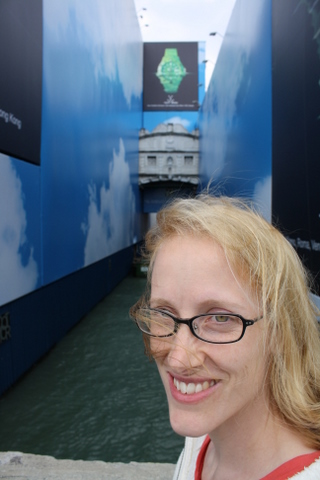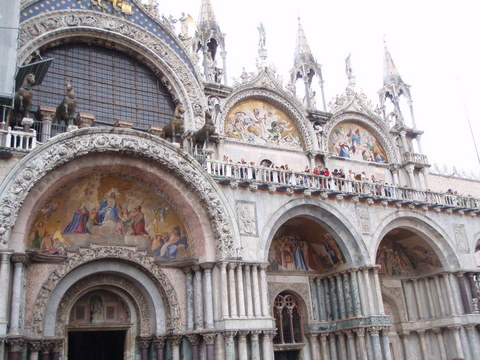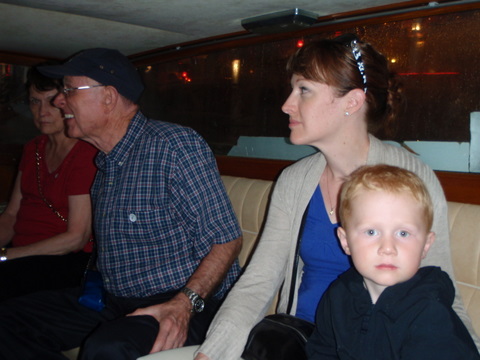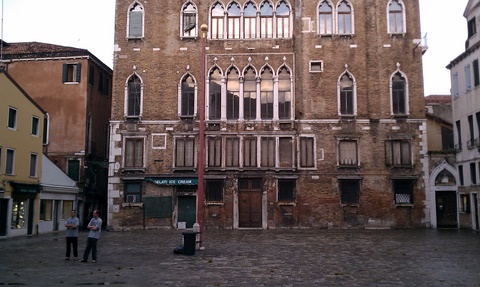Unfortunately, the day we had the most planned in Venice was also the day that it rained. We started out with an 11:00 am walking tour of the city (in the rain) that started at the Royal Gardens (Giardinetti Reali) near Piazza San Marco. Our guide walked us around the Piazza, explaining its history. There are four major buildings surrounding the square: The Doge’s Palace (Palazzo Ducale), the Marciana Library (Biblioteca Marciana), Saint Mark’s Basilica (Basilica Cattedrale Patriachale di San Marco), and the Procuratie, which is made up of several buildings: the Procuratie Vecchie, Procuratie Nuove, St. Mark’s Clocktower, and the Napoleonic Wing of the Procuraties. There’s also a large bell tower in the middle of the square, St. Mark’s Campanile (Campanile di San Marco), which you can climb (we didn’t but should have). One of our first stops was the Doge’s Palace, but we didn’t go in (we visited it the next day, though). We also stopped at the the Bridge of Sighs (Ponte dei Sospiri), which is a bridge from the Doge’s Palace, where criminals were sentenced, to the prison, where they served their time. The bridge was named by Lord Byron based on the suggestion that prisoners would sigh at their final view of beautiful Venice before being taken down into their cells. Here’s Debi in front of what can be seen of the Bridge of Sighs (a lot of Piazza San Marco was under renovation when we visited):

From here we walked to Saint Mark’s Basilica. It would be a major understatement to call this church “gaudy”. Apparently it’s nickname is the Church of Gold, which makes sense given that there are, according to our tour guide, 8,000 square meters of gold leaf on the ceiling and walls. Here’s a shot of the outside:

Our tour included entrance into the Basilic (without waiting, which was nice given the lines). You’re not supposed to take pictures inside, so we didn’t. But someone did and posted it on Wikipedia, so you can see that I’m not kidding about the gold leaf. The Basilica is a pretty good illustration of just how wealthy the Venetians were at the height of their power. After the Basilica, our guide walked us through a number of Venetian streets and alleys, stopping at some of the churches and other places of interest, including the general whereabouts of Marco Polo‘s home in Venice (it’s no longer standing, but they know about where it was). Our tour ended around 1:30 near the Rialto Bridge, which is one of four bridges that crosses the Grand Canal. It rained during the whole tour. After the tour ended, we headed back to the condo. The rain stopped just as we got back to the condo, of course.
Steve and I went out and got pizza and paninis for everyone for lunch. We ate in the condo so we could dry out.
We had another tour – a boat tour of Venice – scheduled for 4:20 that left from Piazza San Marco. It wasn’t raining while we walked to the Piazza, but as soon as we got on the boat, a massive storm hit. It was bad enough that the boat driver pulled up a side canal and tied the boat up for about 10 minutes to wait out the worst of it. The rain was so bad we could barely see out the windows of the boat, both from the windows fogging up on the inside and from the rain on the outside. To wipe the fog off the windows we ended up using some of Toren’s diapers from his backpack. Despite the terrible weather, we continued the tour and learned some interesting things about Venice from our very nice and knowledgeable tour guide. Not having spent much time thinking about the trip beforehand, there was a lot I didn’t know about Venice. Here are some of the interesting nuggets of information I learned:
- The Venetians were a separate city-state from the rest of Italy up until the early 1800s (after they were conquered by France a couple of times under Napoleon). During that time the Republic of Venice was quite powerful and obviously very wealthy. Their wealth derived from their sea trade and most of the territory they controlled was coastal.
- While Catholic, the Venetians did not follow political instruction from the Pope and kind of kept their distance religiously as well, but recognized the Pope’s supremacy religiously.
- Venetian is a separate language from Italian. Many Venetians still speak it.
- At it’s peak, about 250,000 people lived in Venice. Today it’s about 60,000.
- The word “ghetto” comes from “ghetor” or “ghet” (soft “gh”) which means “slag” in Venetian. The Jewish merchants from Germany who moved to Venice ended up in an area with a forge/foundry. The German Jews couldn’t say “ghetto” (soft “gh”), so it became “ghetto” (hard “gh”). This is one of the claimed etymologies of the word “ghetto” (the other is from Italian “borghetto,” which is a dimunitive of “borgo” (borough). The first Jewish ghetto was in Venice.
Here’s a shot of Rosemary, Gary, Suzy, and Ethan inside the boat in the rain:

After the tour, we got off the boat in the rain and basically ran back to the condo. Just as we got back, the rain stopped (of course). It was about 7:00 pm at this point and we were trying to figure out what to do for dinner. We initially thought we could just get take out from one of the nearby restaurants since no one wanted to go back out for fear it would rain again. We checked at a couple of nearby restaurants, but it turns out Venetian restaurants don’t do take out. Who knew?!? We then considered just cooking in the condo, since the kitchen had the requisite pots, pans, and utensils. However, by the time we decided to go this route, the nearby supermarket closed (15 minutes early, of course), so we ended up buying pizza for dinner as well. Here’s a photo of Brent and Steve standing in a campo while we waited for our pizza:

Brent, Steve, Ethan and I, while waiting for the pizza, also stopped at a church turned museum (pretty common in Venice; a lot of the churches are now museums) exploring the history of the violin and of Vivaldi. It was a little awkward because it talked about Vivaldi, but all the exhibits were musical instruments and Vivaldi was a composer, not a maker of music instruments. Regardless, it was cute little free museum that occupied our time while we waited for our pizza. Oh, and I did learn that Vivaldi was a priest who was reprimanded by the Catholic Church for his fixation on music and the theater. That was interesting.
That pretty much wrapped up our first full day in Venice.
![]()
Leave a Reply